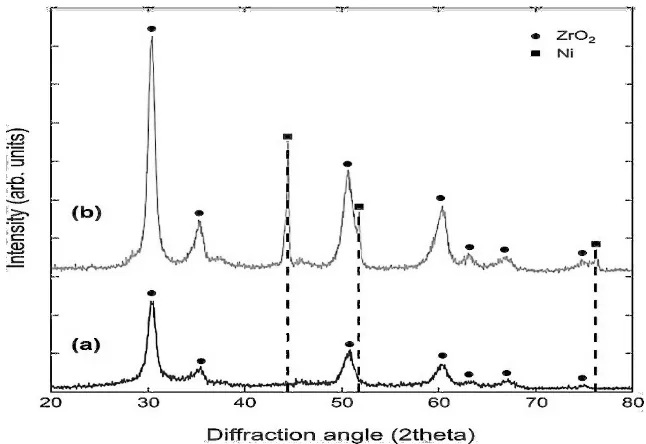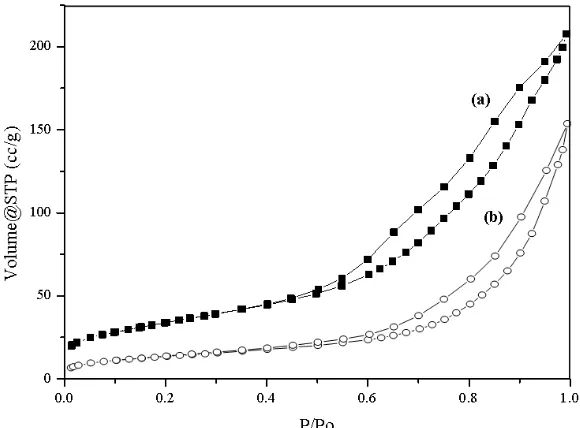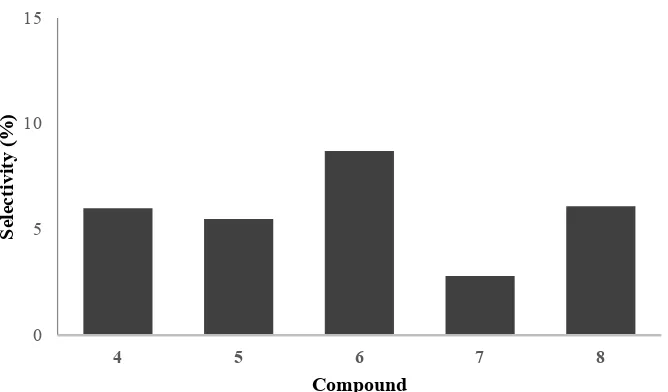The journal homepage www.jpacr.ub.ac.id p-ISSN : 2302 – 4690 | e-ISSN : 2541 – 0733
Hydrogenation/Deoxygenation (H/D) Reaction of
Furfural-Acetone Condensation Product using Ni/Al
2O
3-ZrO
2Catalyst
Adam Mahfud, Edi Priyo Utomo, Siti Mariyah Ulfa*
Chemistry Department, Faculty of Science, Brawijaya University, Jl. Veteran Malang 65145 Indonesia
*
Corresponding email : [email protected]
Received 19 May 2016; Revised 25 July 2016; Accepted 1 August 2016
ABSTRACT
The catalytic hydrogenation/deoxygenation (H/D) reaction was carried out using Ni/Al2O3 -ZrO2 catalyst. The 10% (wt/wt) of Ni were impregnated on Al2O3-ZrO2 (10NiAZ) by wet impregnation method followed by calcination and reduction. X-Ray diffraction analysis showed that Ni deposited on the surface, with specific surface areas (SBET) was 48.616 m2/g. Catalyst performance were evaluated for H/D reaction over furfural-acetone condensation products, mixture of 2-(4-furyl)-3-buten-2-on and 1,5-bis-(furan-2-yl)-pentan-3-one. The reaction was carried out in a batch, performed at 150°C for 8 hours. The H/D reaction gave alkane derivatives C8 and C10 by hydrogenation process followed by ring opening of furan in 15.2% yield. While, oxygenated product C10C13 were also detected in 17.2% yield. The increasing of the pore volume of 10NiAZ might enhance catalyst activity over H/D reaction. The alkene C=C bond was easy to hydrogenate under this condition because of the lower bond energy gap.
Key word: Hydrogenation, deoxygenation, Ni/Al2O3-ZrO2, condensation, furfural
INTRODUCTION
Conversion of biomass into renewable fuels and chemicals become great attention among researchers, especially for the production of liquid transportation fuels [1,2]. Furfural is biobased chemicals which obtained from acid hydrolysis and dehydration of lignocellulosic material. Transformation of furfural into fuels is reported by aldol condensation with ketone followed by catalytic hydrogenation/deoxygenation (referred as H/D) to get C8C13 diesel
fractions [3,4].
Condensation of furfural (1) with ketone have been widely reported using basic mixed oxide gave the mixture of 2-(4-furyl)-3-buten-2-on (2, monomer C8) and
1,5-bis-(furan-2-yl)-pentan-3-one (3, dimer C13) [5,6]. Ulfa et al (2015) reported the condensation of furfural and
acetone by reflux produce dimer C13 as major compound. However, monomer C8 is observed
as the main product when the reaction performed in batch reactor [7]. Since both condensation product is water-insoluble and having unsaturated double bonds of C=C and C=O, catalytic H/D reaction become fascinating to studied .
Extensive H/D reaction of lignocellulosic-based material using supported noble metal catalysts, such as Pt/SiO2 [8] and Pd/C [9] have been reported. These catalysts showed
excellent performance for phenolic derivatives, but the conversion or selectivity is inferior for
The support for the metal is another key factor determining the successful of H/D reaction. Alumina (γ-Al2O3) was known as good support for deoxygenation of the
oxygenated compound for producing hydrocarbons. It has a high surface area and Lewis acid site to activate the interaction with H2. However, γ-Al2O3 have a metastable structure which
will transform into boehmite when the reaction is performed in water solvent. In addition, the formation of coke is easily deposited on its surface thus decrease the activity [11]. To overcome this problem, we promote the use double oxide support catalyst to enhance its performance. By the addition of zirconia (ZrO2) as second metal oxide supposed not only
enhance the stability of the catalyst but also promote adsorption and dissociation of water on the surface of catalyst [12].
In this work, we report the preparation of Nickel-based catalysts supported on Al2O3
-ZrO2 (NiAZ) for the H/D reaction of furfural-acetone condensation products into
hydrocarbon derivatives under water solvent. This reaction is interesting to study because the substrate consists with alkene C=C, furan C=C, acyl C=O and furan COC in conjugated systems, then various reaction products can be expected.
EXPERIMENT
Chemicals and instrumentation
Furfural was obtained from Sigma-Aldrich with purity >98% and used without further purification. Ultra-High-Purity (UHP) nitrogen gas (>99.99%) and hydrogen gas from a local vendor. Nickel(II) nitrate (Ni(NO3)2.6H2O), Zirconium(IV) oxide chloride octahydrate
(ZrOCl2.8H2O), and aluminum oxide (γ−Al2O3) were supplied by Merck Germany. Acetone,
methanol, and dichloromethane are from Merck Germany. Magnesium oxide (MgO) was obtained from the local vendor and used after calcination at 650oC for 2 hours.
Instrumentation used for analysis are Shimadzu UV-Vis 1600Series, Shimadzu FTIR 8400S (sample analyzed using NaCl plate), GCMS QP5050A Shimadzu with FID detector and ZB-1MS column.
Procedure reaction Catalyst preparation
Ni/Al2O3-ZrO2 (referred as Ni/AZ) were prepared with 10%wt Ni loading (10Ni/AZ)
using wet impregnation refers to Zhang methods [4] with some modification. ZrOCl.8H2O
(9.15 g) were dissolved in distilled water with continuous stirring and ammonium solution dropped slowly into the solution until pH = 8. After Zr(OH)4precipitate appears, 3.5 g of γ
-Al2O3 added and stirred for 12 h at 75°C. Afterward, the precipitate was filtered and washed
with distilled water to remove excess of chloride ions completely. Composite of Al2O3
-Zr(OH)2 were dried at 120°C for 24 h then calcined at 550°C for 5 h under N2 flowing. The
obtained powder was denoted as Al2O3-ZrO2 (referred as AZ). An appropriate amount of
Ni(NO3)2.6H2O (10%wt Ni over AZ) was dissolved in distilled water and stirred for 24 h at
room temperature. After filtration, the obtained solid was dried overnight at 120°C, calcined at 550°C for 5 h and reduce at 500°C for 5 h using H2 flow. The obtained catalyst 10%wt
Ni/Al2O3-ZrO2 denoted as 10NiAZ.
Catalyst characterization
connected to EDX Swift ED3000 analyzer. The actual Ni loading was analyzed using XRF PANalytical Type Minipal 4. The BET surface areas, average pore diameter, and pore volume were measured by N2 adsorption at -196°C using Quantachrom NOVA 1200 after
degassed at 300oC.
Activity test for Hydrogenation/Deoxygenation (H/D) reaction
Condensation of furfural and acetone were carried out in autoclave oil batch reactor equipped with a magnetic stirrer. The reactor was loaded with 0.4 g of activated MgO, furfural (1) (2 mL, 0.0121 mol), acetone (3.6 mL, 0.042 mol), and 20 mL of deionized water. Air is purged out from the reactor by vacuum and flowed by nitrogen gas up to 40 psi before starting the condensation reaction. The reaction was carried out at 100°C for 6 h. The condensation product obtained as a mixture of 2-(4-furyl)-3-buten-2-on (2) and 1,5-bis-(furan-2-yl)-pentan-3-one (3) after characterized by UV-Vis spectrophotometer, FTIR, and GC-MS.
The H/D reaction was carried out in the liquid phase using batch reactor. For each reaction, activated 10NiAZ (0.02 g), the mixture of 2 and 3 (0.5 g), and solvent (CH3COOH:
H2O, 19:1 v/v) were added to the reactor. After purging air, the reactor was pressurized with
H2 gas until 40 psi. The reactor was heated at 150°C for 8 h. The liquid reaction product was
filtered and extracted using ethyl acetate, then analyzed by GC-MS.
RESULT AND DISCUSSION Characterization of Catalysts
The XRD patterns of the AZ and 10NiAZ are presented in Figure 1. The peak was identified according to JCPDS reference standard. Compared with AZ catalyst, 10NiAZ showed the additional peak at 2θ = 37°, 43°, and 64° corresponds to metallic nickel (Nio) in the lattice form Ni(111), Ni(200), Ni(220). An additional peak at 2θ =30°, 35°, 50°, 60°, 63°
Figure 1. Diffractogram of (a) AZ support and (b) 10NiAZ catalyst
is observed as ZrO2 in cubic phase [13]. Calcination of the catalyst at 500oC under hydrogen
= 37°, 43°, and 64°. However, the diffraction peak of Al2O3 was not detected because the
amorphous Al2O3-ZrO2 composite was formed. Impregnation of Ni significantly inhibited the
crystallization of individual Al2O3 crystal as reported by Han et al (2013) [14].
Figure 2. SEM micrograph of (a) AZ support and (b) 10NiAZ catalyst (1000x optical zoom)
Profil of AZ and 10NiAZ under Scanning Electron Microscope (SEM) were displayed in
Figure 2. After impregnation of nickel, the morphology of 10NiAZ catalyst is different compared to the support. The 10NiAZ catalyst exhibits smaller particle size with irregular shapes. The existence of nickel change the morphology of AZ and reduced the particle size [13]. The percentage of metal loading was analyzed by X-Ray Fluorescence (XRF) in Table 1. The Ni particles are well dispersed on the surface and the actual Ni was 10.2%, higher than the expected with relative error under 10% which is insignificant.
Figure 3. N2 adsorption-desorption of (a) AZ support and (b) 10NiAZcatalyst
support has large surface areas (122.945 m2/g) and large pore volume (0.330 cc/g). For 10NiAZ catalysts, showed the decreasing surface area (48.616 m2/g), and pore volume (0.199 cc/g) by Ni deposition on AZ support, similar with the reported data by Han (2013)[15]. In contrast, the pore diameter of 10NiAZ is higher than AZ support because of the decreasing of 10NiAZ catalyst particle size. This could be proved with SEM results before and after loading (Figure 2). However, the characteristic of the catalyst is an important factor accounting for the activity of H/D reaction.
Table 1. Physical properties of AZ support and 10NiAZ catalyst
Catalyst Metal
Activity test for Hydrogenation/Deoxygenation (H/D) reaction
The condensation reaction of furfural (1) and acetone was carried out in a batch reactor using MgO as a catalyst in the presence of water as a solvent. The condensation product was obtained after filtration and extraction using dichloromethane. Analysis of the products by UV-Vis spectrophotometer showed a bathochromic shift from λmax 271 nm (furfural, 1) to
λmax at 318 and 383 nm, by the addition of conjugated system [7]. The condensation product
showed in Scheme 1, that is the mixture of 2-(4-furyl)-3-buten-2-on (2, monomer C8) and
1,5-bis-(furan-2-yl)-pentan-3-one (3, dimer C13), similar with previously report [5,13]. Based
on Gas Chromatography (GC-MS) analysis, conversion of 2 and 3 was 80% with selectivity over 2 achieved at 52.5%.
Scheme 1. Condensation of furfural with acetone over MgO catalyst
The mixture of 2 and 3 was directly hydrogenated/deoxygenated (H/D) using 10NiAZ as a catalyst. The reaction was carried out in a batch reactor using acetic acid and water (1:19 v/v). Prior H/D reaction, the reactor purged with H2 gas until 40 psi to start the
pathways, limited by partial ring opening and hydrogenation. Poly-alcohol derivatives 7
subjected from hydrogenation of dimer 3 followed by ring opening of furan (3a-3c) to aldehyde-ketone derivatives (3I). The existence of hydroxyl groups was also detected by FTIR analysis. However, these simultaneous reaction pathways with parallel reaction network were previously reported on hydrogenation/hydrodeoxygenation reaction of furfural derivatives using Raney Nickel and Pt catalysts in two-step reaction [17].
O
Scheme 2. The plausible reaction pathway to access H/D products
Figure 4. Selectivity of H/D product over 10NiAZ catalyst
CONCLUSION
The H/D reaction of furfural-acetone condensation products using 10NiAZ was studied using batch reactor at 150oC for 8 h. The mixture of alkane derivatives C8 and C10 (15.2%) and oxygenated compounds C9C13 (17.2%) was evaluated using GCMS. The predominant formation of oxy-compounds was explained by unstable AZ support under hydrothermal reaction. The parallel reaction initially occurs by hydrogenation reaction of C=C alkane followed by C=O and finally ring opening of COC furan give alcohol derivatives.
ACKNOWLEDGMENT
This work was supported financially by the PUPT research grant through DIPA of Brawijaya University 007/Add/SP2H/PL/DIT.LITABMAS/V/2015 from Directorate of Research, Technology, and Higher Education, Indonesian Ministry of Education. We thank to Prof. Didik Prasetyoko for guidance using SEM, XRD and physical properties of catalysts and Ms. Indah Nur Pramesti for GCMS measurement.
REFERENCES
[1] A. Corma, O. de la Torre, M. Renz, N. Villandier, Angew. Chem. Int. Ed. 2011, 50, 2375–2378.
[2] A. Corma, S. Iborra, A. Velty, Chem. Rev. 2007, 107, 2411–2502.
[3] G. W. Huber, J. N. Chheda, C. J. Barrett, J. A. Dumasic, Science 2005, 308, 1446– 1449.
[4] X. Zhang, Q. Zhang, T. Wang, L. Ma, Y. Yu, L. Chen, Bioresour. Technol. 2013, 134, 73–80.
[5] L. Faba, E. Díaz, S. Ordóñez, Appl. Catal. B Environ. 2012, 113–114, 201–211.
[6] O. Kikhtyanin, V. Kelbichová, D. Vitvarová, M. Kubů, D. Kubička, Catal. Today 2014, 227, 154–162.
[7] S. M. Ulfa, I. Sari, C. P. Kusumaningsih, M. F. Rahman, Procedia Chem. 2015, 16, 616–622.
[8] M. Hellinger, H. W. P. Carvalho, S. Baier, D. Wang, W. Kleist, J.-D. Grunwaldt, Appl. Catal. Gen. 2015, 490, 181–192.
[9] H. Shafaghat, P. Sirous Rezaei, W. M. A. W. Daud, RSC Adv 2015, 5, 33990–33998.
0 5 10 15
4 5 6 7 8
S
el
ec
tivi
ty
(%
)
[10] L. Faba, E. Díaz, S. Ordóñez, Appl. Catal. B Environ. 2014, 160–161, 436–444. [11] D. C. Elliott, Energy Fuels 2007, 21, 1792–1815.
[12] V. N. Bui, D. Laurenti, P. Delichère, C. Geantet, Appl. Catal. B Environ. 2011, 101, 246–255.
[13] N. Rahemi, M. Haghighi, A. A. Babaluo, M. F. Jafari, P. Estifaee, J. Ind. Eng. Chem.
2013, 19, 1566–1576.
[14] S. J. Han, Y. Bang, J. Yoo, K. H. Kang, J. H. Song, J. G. Seo, I. K. Song, Int. J. Hydrog. Energy 2013, 38, 15119–15127.
[15] S. J. Han, Y. Bang, J. Yoo, J. G. Seo, I. K. Song, Int. J. Hydrog. Energy 2013, 38, 8285–8292.
[16] J. Luo, L. Arroyo-Ramírez, J. Wei, H. Yun, C. B. Murray, R. J. Gorte, Appl. Catal. Gen. 2015, 508, 86–93.
[17] Y. Li, X. Huang, Q. Zhang, L. Chen, X. Zhang, T. Wang, L. Ma, Appl. Energy 2015, 160, 990–998.



